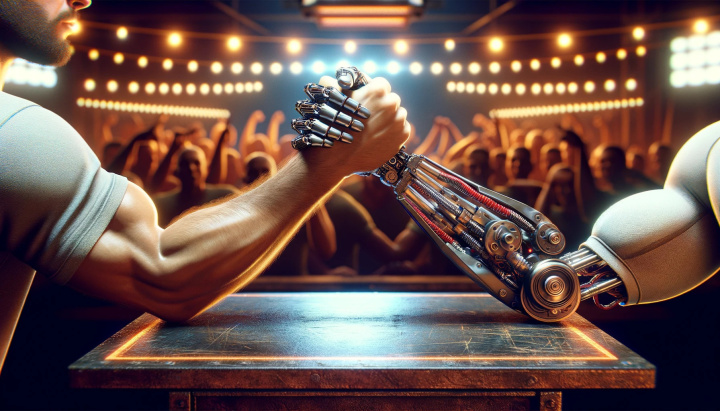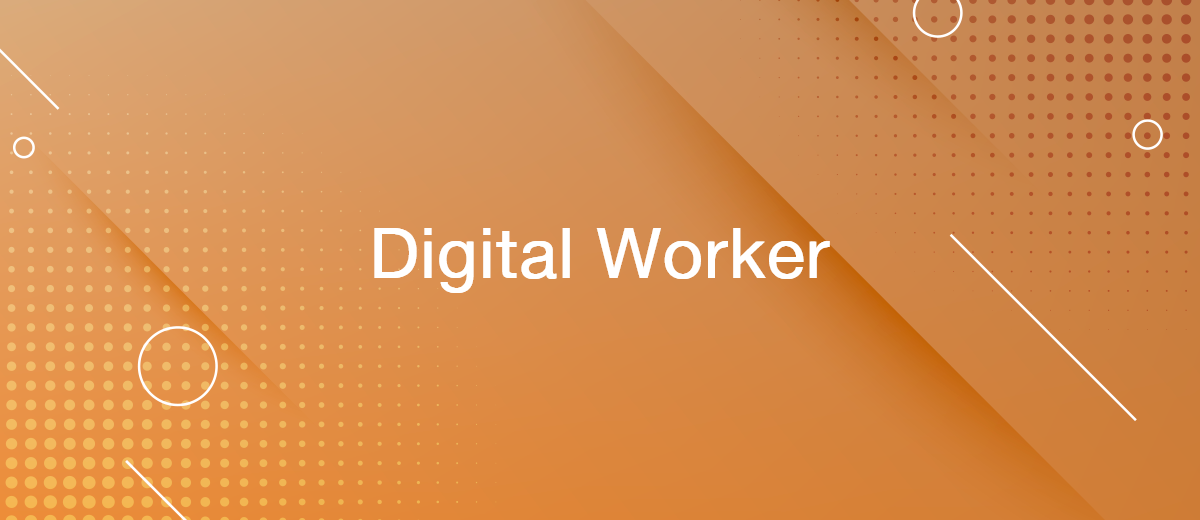Digital Worker Evolution: Shaping Tomorrow's Tech
The organization of labor today is experiencing a large-scale digital transformation in all areas and industries. The impetus for transformation was given by the latest technologies and the rapid development of artificial intelligence. Services that automate a number of routine work tasks, bots, chatbots with AI – all of this is now being actively implemented and used. They increase labor efficiency and make work much easier. However, progress did not stop there. Vice versa. IT specialists have taken things to new heights by creating digital workers. Such an assistant complements a human specialist and significantly improves productivity by taking on not a specific task, but an entire process.
From our article you will learn what a digital worker is, what its value and potential are, as well as the advantages and disadvantages of this technology. In addition, we will tell you why and where it is used, how it differs from a regular bot, and whether it can compete with a human.
Definition of the Term
Previously, a digital worker was a person whose responsibilities required digital skills. This category included those who worked with a computer and any programs. Today, the situation has changed dramatically. Who is a digital worker now? This is the name given to a software robot assistant endowed with artificial intelligence, trained to perform many sequential tasks and even entire processes together with human colleagues.
Analytical research company Forrester offers the following digital worker definition:
IBM has expanded this definition to include that the assistant can perform important parts of complex processes using a range of skills learned during training. To achieve this, it uses the capabilities of artificial intelligence: machine learning, natural language processing and computer vision.
What is a Digital Worker
A digital worker is a new generation of virtual employees, created based on intelligent automation technology that combines RPA with AI technologies. It is a team of bots with analytical, cognitive and transactional abilities, endowed with artificial intelligence and acting as a single unit. With the help of such an assistant, you can automate entire business functions. For example, instruct it to systematically and regularly issue invoices to clients so that it handles this process from start to finish. Having introduced itself into the work environment, it complements and improves the work of individuals. It completely imitates them and interacts with their colleagues.

By learning and developing, digital workers will eventually be able to prioritize certain work processes. Reaching this level allows them to perform, for example, the duties of accounts payable or IT operations specialist with little or no human supervision.
What and Where is it Used for
A digital worker has two main goals. The first is to automate business processes and increase human efficiency without increasing their workload. The second is to provide the opportunity to switch to more complex, strategic or creative tasks. This benefits not only the company’s management and its employees. Clients and consumers also benefit from the implementation of this technology. Apparently, the developers of such an assistant initially “hardwired” the win-win formula into it.
Let's consider what is a digital worker in automation of business. Such assistants are useful in almost all areas. They will be helpful in the following areas:
- Supplies. They help retail giants (for example, Amazon) check product prices, warehouse balances and inventory levels.
- Procurement. Transmit current data about suppliers and their products to specialists who are authorized to make purchasing decisions. Thanks to them, a person chooses the truly optimal option.
- Customer service. They answer user questions about tariff plans, benefits, and innovations online. They collect the necessary data and send complex cases to the company’s experts, thus increasing the value of its employees.
- Product and sales support. Answer common questions about the company's products, helping sales staff manage both potential and existing customers. Analyze and route requests, distributing them according to urgency. Thus, high-priority requests are always processed on time, resulting in an increase in the quality of customer service. Examples of implementing digital workers into the ecosystem of large companies: Digital Azure IT Admin, Digital Google Cloud IT Admin, Digital AWS IT Admin.
- Finance. In offline mode, the duties of three specialists involved in lending are partially performed at once. They assist the customer service representative, the billing agent, and the cash decision maker. Such an assistant is capable of managing the business process “from order to cash.” Examples of digital worker solutions: Digital SAP Accounts Payable Clerk and Digital Oracle Accounts Payable Clerk.
- HR. They take on repetitive, time-consuming tasks, freeing people from them so they can concentrate on making decisions. For example, IBM HR employees use the services of HiRo, a digital worker. It helps them collect and organize information that is important for career growth.
Digital workers significantly increase the throughput of human employees. Thanks to this, companies can intelligently redistribute their workforce and focus it on solving strategic problems.
What Tasks can a Digital Worker Perform
A wide range of digital worker capabilities allows a business to choose exactly the solution that will help best meet its needs and achieve its goals. Such an assistant can perform many tasks, thereby making the work of their human colleagues easier:
- organization of meetings and events;
- collection and preparation of documentation;
- obtaining approvals and permits;
- processing, analysis and classification of customer complaints;
- performing many sequential operations to service the client;
- formation of a commercial offer;
- identifying signs of fraud.
Routine, monotonous, boring tasks quickly bore even the most responsible professionals, having a negative impact on their effectiveness over time. Delegating them to a digital worker allows them to refocus on more significant and, most importantly, interesting responsibilities.
The Value and Potential of a Digital Worker
In 2022, the business social network LinkedIn conducted a survey. It found that 74% of executives consider skills shortages among their employees to be a real threat to sales and revenue growth. At the same time, 64% of employers consider it an internal issue, mainly related to attracting and retaining staff. Many companies are actively struggling with the lack of necessary skills among their specialists, the shortage of highly qualified specialists, and burnout. They use various methods for this. With the advent of new technologies, they are looking at digital workers or are already using them. With their help, they strive to improve the efficiency and productivity of the team.
The main value and most attractive advantage of a digital worker is that it allows a person to devote more time to the most important and exciting tasks. We will explain what this means in practice. As you know, mental exhaustion can overtake professionals who have mastered their craft down to the smallest detail and have hit a ceiling in their development. In such a situation, the specialist either loses productivity due to boredom or quits to go searching for a more interesting job. Having a digital worker on staff can retain talent while protecting them from burnout. Its potential allows them to open up new horizons: managing new projects and solving new problems that will expand their existing skills.
Difference from other Automation Programs
At first glance, a digital worker is similar to other software used to automate business tasks, such as an RPA bot or chatbot. However, in reality, it is different from them.
The main differences of a digital worker:
- Identity. It can have its account with a personal login and password, like a real person. Such an assistant is a virtual team member who can interact with several human colleagues at once. It accurately recognizes who it is in contact with, so it can strictly follow company safety protocols.
- Planning. It knows how to operate with various skills, selecting from its arsenal the right one according to a specific work request. A digital worker intuitively understands how best to get the job done based on previous experience and knowledge. It does not require additional preparation or training.
- Memory. It is endowed with memory, thanks to which it does not forget about previous contacts and interactions with it. When a person launches their assistant again, it remembers perfectly well who turned it on and what they worked on together.
What is the Difference Between a Digital Worker and a Bot?
You can understand the difference between a bot and a digital worker by understanding the definitions. So, let's look at what an RPA bot, a chatbot, and a digital worker are.
An RPA bot is a program created to perform predefined simple tasks that are constantly repeated (meeting reminders, filling out documents, sending messages). It is used when it is necessary to accelerate this process many times and at the same time guarantee to avoid errors. Examples: online booking of a patient with a doctor; retrieving customer order information from a web-form or email and then automatically entering it into the system.
A chatbot is a program that simulates communication with a person, usually on a web page, via email, SMS or instant messengers. It is used when employees or clients need to get answers to questions, regardless of the time of day or night. Operates 24/7, without weekends or holidays. It can be supplemented with artificial intelligence. Examples: Meta's BlenderBot, Ada's Health Chatbot, Domino's Pizza Messenger Chatbot.
A digital worker is a virtual assistant developed using RPA and artificial intelligence technologies. It was created to autonomously perform significant fragments of complex processes to help humans. It is used when employees need to switch from a number of routine business processes to larger ones. Moreover, we are talking not only about individual tasks, but also about complex operations. For example, such an assistant will easily fulfill the following client request: “Schedule a flight for me to Chicago on December 30th with visits to my favorite locations and a room reservation at a local hostel, closer to the center. Organize a transfer for me to and from the airport.” To satisfy it, a digital worker will need to use several sources at once. An ordinary chatbot is simply not capable of this. You’ve probably already seen examples of digital workers in the “What and Where is it Used for” section.
Well, have you figured it out? If there is still a misunderstanding, we offer the simplest explanation “digital worker vs bot”. Remember that every digital worker is essentially a chatbot, but not every chatbot is a digital worker.
Is a Digital Worker an Advanced Bot?
Some people believe that a digital worker is just an advanced bot, but this is not true at all. Despite the fact that both a bot and a digital worker are tools for business automation, they are distinguished by one fundamental feature. What is the main difference between an automated digital worker and a traditional automated bot?
The bot used in RPA concentrates on a specific single task. It does its job only the way it was programmed. If it is created using AI technology, it gains the ability to grow and adapt to tasks of a higher level of complexity. However, it will not be able to take on a complex multi-tasking process. It does not have the appropriate skills and abilities. Examples of functions that such bots perform include copying and pasting data, reading documents, sending emails, and so on. A digital worker differs from them in that it is engaged in the business process delegated to it from beginning to end. In addition, it is capable of solving tasks of a high level of complexity, thereby expanding the capabilities of human employees.
Digital Worker VS Human

The digital workforce has several capabilities that give it a competitive advantage over the human workforce. It surpasses in learning, information processing and analytics.
- Education. A digital worker uses artificial intelligence technologies. They allow it to independently learn non-stop and quickly adapt to new processes. It develops faster than humans. In addition, it takes much less time than searching, hiring and training a new employee.
- Data processing. Such an assistant will work with unstructured data, systematizing it, for much less money than you need to pay a person. Another significant advantage is the absence of errors arising from the human factor.
- Analysis. Data is fundamental to business today. Competent analytics makes it possible to achieve the desired result and goal. A digital worker qualitatively analyzes large amounts of data and draws conclusions. Moreover, it copes with this task much more accurately and faster than a human.
If a company plans to automate some processes, its management must take into account one important point. The main purpose of implementing and using a digital worker is to strengthen the team of employees and help them expand their activities. Such assistants are capable of a lot, and yet it is impossible to completely replace the human workforce with a digital one. Despite their enormous technological potential, they still cannot become an exact copy of a person. An individual approach to each client, the manifestation of perseverance or, conversely, loyalty depending on the situation, non-standard thinking. All this is not yet available to the machine. In addition, if you ask consumers of goods or services with whom they want to communicate, most often they will prefer a live interlocutor.
Advantages and Disadvantages of Technology
Using a digital worker offers many significant benefits to businesses. Thanks to it, the company can:
- perform certain tasks and processes around the clock, without breaks or days off;
- increase the productivity and efficiency of your employees;
- reduce the number of errors and associated costs;
- improve the financial microclimate.
Despite the significant benefits of adopting a digital workforce, it is not without its drawbacks. The main disadvantages are:
- starting financial investments;
- time spent on installing and configuring the assistant;
- development of pathological dependence on technology;
- minimizing creativity and human interaction (in some cases).
The Future of Work – Unleashing Human Potential
The rapid development of new technologies has given us digital workers – virtual employees that imitate people and automate business. Now persons no longer need to engage in boring, monotonous processes consisting of a series of repetitive tasks. By delegating them to a virtual assistant colleague, they get the opportunity to switch to higher-level responsibilities. As a rule, they are associated with strategic activities, idea generation, creativity, and innovation. At the same time, the level of quality and productivity not only does not suffer, but also increases significantly.
The workforce of the future will be a harmonious mix of people and digital workers. At the same time, each of them will improve and strengthen the other. People will focus on acquiring new skills, developing and increasing their own professional value.
Routine tasks take a lot of time from employees? Do they burn out, do not have enough working day for the main duties and important things? Do you understand that the only way out of this situation in modern realities is automation? Try Apix-Drive for free and make sure that the online connector in 5 minutes of setting up integration will remove a significant part of the routine from your life and free up time for you and your employees.

